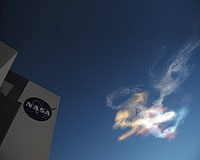 |
Houston TX (SPX) Feb 15, 2011 Astronauts aboard the International Space Station this spring will conduct six experiments designed by middle school students from across the country. The winning proposals of the "Kids in Micro-g" Challenge are from California, Idaho, Montana, New York, Pennsylvania and Washington state. In its second year, the program offers students in fifth through eighth grades an opportunity to design experiments or simple demonstrations for testing both in the classroom and in the station's microgravity environment. A team of representatives from NASA centers selected the winners from among 62 proposals. The experiments will study the effect of weightlessness on various subjects and show what the environment reveals about the laws of physics. "This is a wonderful opportunity for these students to learn how scientists and astronauts work together to develop new technologies for space exploration and to learn more about how things work on Earth," said Mark Severance, International Space Station National Laboratory Education projects manager at NASA's Johnson Space Center in Houston. "By engaging students in interesting science experiments, teachers can pique a child's interest while helping develop higher-level thinking skills." The winning experiments came from students at these schools: + Chabad Hebrew Academy in San Diego, for "Attracting Water Drops." This experiment will determine if a free-floating water drop can be attracted to a static charged rubber exercise tube. + Neighborhood After School Science Association in Ava, N.Y., for "Flight of Paper Rockets Launched by Air Cannon." This experiment will determine the direction and distance traveled by a paper air rocket launched in microgravity. + Key Peninsula Middle School in Lakebay, Wash., for "Pondering the Pendulum." This experiment will examine the effects of microgravity on a pendulum. + Potlatch Elementary in Potlatch, Idaho, for "Pepper Oil Surprise." This experiment will investigate the interaction of liquid pepper/oil and water in a plastic bag in microgravity. + Gate of Heaven School in Dallas, Pa., for "Buoyancy in Space." This experiment will determine if the buoyancy of an object is affected in a microgravity environment. + Will James Middle School in Billings, Mont., for "A Comparison of Dispersion of Liquid Pepper under Microgravity and Earth Conditions." This experiment will compare the dispersal of liquid pepper in microgravity to Earth's gravity. The apparatus for the experiments was constructed using the same materials as in a tool kit provided to astronauts on the space station. The materials in the kit are commonly found in the classroom and used for science demonstrations. The experiments will take no more than 30 minutes to set up, run and take down.
Share This Article With Planet Earth
Related Links Kids in Micro-G Space Tourism, Space Transport and Space Exploration News
 NASA Announces Fiscal Year 2012 Budget
NASA Announces Fiscal Year 2012 BudgetWashington DC (SPX) Feb 15, 2011 NASA announced Monday an $18.7 billion budget request for fiscal year 2012 that supports a reinvigorated path of innovation, technological development and scientific discovery. The budget supports all elements of NASA's 2010 Authorization Act, which was passed by a strong bipartisan majority of Congress and signed into law by President Obama. "This budget requires us to live within our mea ... read more |
|
| The content herein, unless otherwise known to be public domain, are Copyright 1995-2010 - SpaceDaily. AFP and UPI Wire Stories are copyright Agence France-Presse and United Press International. ESA Portal Reports are copyright European Space Agency. All NASA sourced material is public domain. Additional copyrights may apply in whole or part to other bona fide parties. Advertising does not imply endorsement,agreement or approval of any opinions, statements or information provided by SpaceDaily on any Web page published or hosted by SpaceDaily. Privacy Statement |